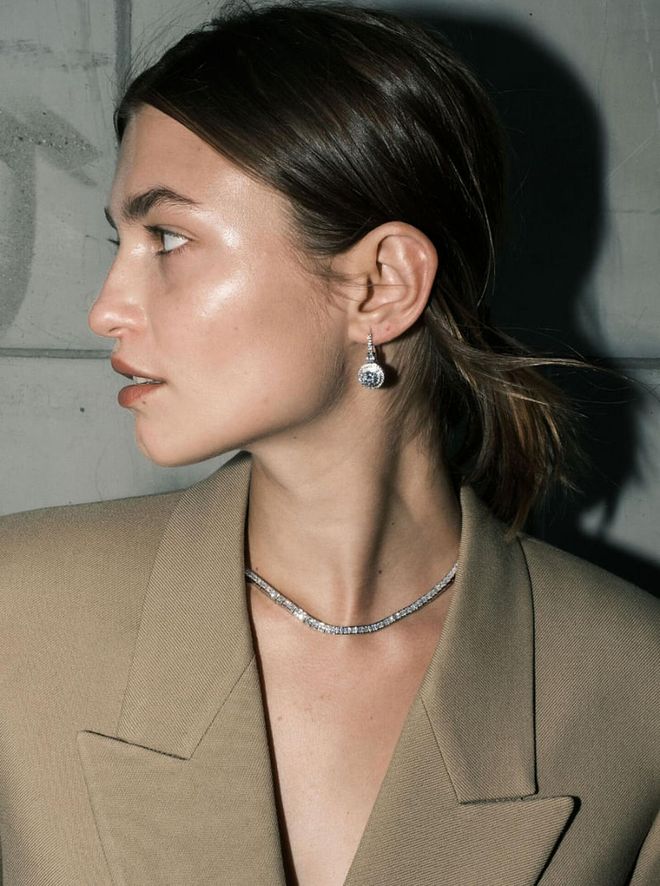Why Don't You Buy...That Necklace From Your Instagram Feed?
Dorsey has made a splash with lab-grown stones and hard-to-believe-it pricing.


Photo: Dorsey
Dorsey Kate Diamond White Sapphire Necklace
When it comes to covetable, iconic, always-in-style jewelry box staples, there's not much more list-topping than a tennis necklace. Designed as the ultimate in high-wattage everyday versatility, it's the type of piece that looks good worn solo or amidst the beautiful chaos of an entire layered situation of chains—essentially, anyway, at any time.
The problem for some of us, of course, has always been the price tag. With a style that includes a full circle of stones, that’s a lot of carats which, in turn, commands a high price tag. The option's always existed to go an alternative route, but that's never presented a shopping spectrum so much as a miles-long seesaw. On one side, the real-deal, vault-required stuff. On the other? Cubic zirconia haphazardly tucked into cheap settings, with clasps not to be counted on and shoddy "craftsmanship" (quotation marks most definitely required) that meant wearing it on the regular almost required acceptance that one day it would fall off, never to be seen again.
Related article: Discover The La Panthère Universe At Cartier’s ‘Into The Wild’ Exhibition

Princess Cut, Lab-Grown White Sapphire Silver Riviere Necklace, $939, Dorsey (Photo: Dorsey)
Princess Cut, Lab-Grown White Sapphire Silver Riviere Necklace, $939, Dorsey
Enter Meg Strachan with her brilliant idea for Dorsey. Hatched while she was working at a string of impressive startups (her resume includes stints at Goop, Anine Bing, and Girlfriend Collective) it was inspired by her grandmother’s love of vintage costume jewelry.
"I'd look through her archives at all these pieces from the '30s to the '90s that weren't incredibly expensive but so beautiful—and they felt so expensive," she tells BAZAAR.com. "The reason was because of the craftsmanship. It was costume jewelry that felt like fine because everything was created by the same designers and at some of the same factories."
Those sort of pieces from decades past were made with a quality that current fast-fashion purveyors have long since eschewed. Clasps stayed clasped; stones stayed in place. Motivated by knowing what could be done, Strachan built Dorsey with a mindset that's not seen as often in today's fashion world. "Our goal is to create beautiful pieces that are more affordable but feel expensive," Strachan adds from her base in Los Angeles. "People start to get confused, but lab-grown gemstones are really gemstones. Everyone is always, 'Real or fake? Cubic zirconia or diamonds?' They have two modes, but there's this big mode in between, with incredible quality you can wear everywhere, all the time."
Related article: The Ondes Et Merveilles De Chaumet Shows Us A Daring New Way To Pay Tribute To The Oceans
That's where Dorsey has found its sweet spot—and a big win. Lab-grown white sapphires are used most commonly in place of diamonds, offering sparkle at a fraction of the price (tennis bracelets start around $220; necklaces at $310). And, speaking from first-hand experience, these are items made well enough to be worn regularly—slept in, showered in, etc.—without fear of damage.
"The only reason I take things off is because I'm always trying new samples on," she says. "You don't have to be careful with it; you can wear it the same way you would a very expensive piece of jewelry. We sit in that space.” She okay'ed my list of wear occasions (pool, gym, bed), only suggesting to skip the ocean since sand can get in the clasp and make taking it off tricky.
If you've found yourself eyeing something only to spot the horrid "sold out" tag, check back frequently. "We sold through inventory that we were supposed to have in stock for months—it's not how we planned," she admits. "We're desperately trying to get more stock but just haven't been able to keep up with demand. It's a great problem to have."
This article originally appeared on Harper's BAZAAR US.